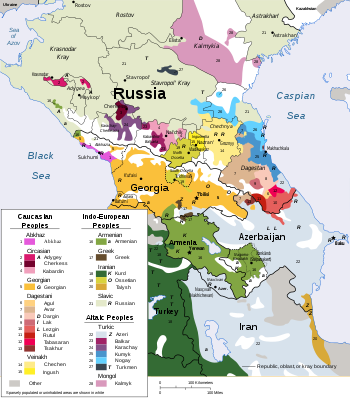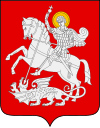Svan language
The Svan language (Svan: ლუშნუ ნინ lušnu nin; Georgian: სვანური ენა svanuri ena) is a Kartvelian language spoken in the western Georgian region of Svaneti primarily by the Svan people.[3][4] With its speakers variously estimated to be between 30,000 and 80,000, the UNESCO designates Svan as a "definitely endangered language".[5] It is of particular interest because it has retained many archaic features that have been lost in the other Kartvelian languages.
| Svan | |
|---|---|
| ლუშნუ ნინ Lušnu nin | |
| Pronunciation | [luʃnu nin] |
| Native to | Georgia |
| Region | Svaneti Abkhazia (Kodori Gorge) |
Native speakers | 14,000 (2015)[1] |
Kartvelian
| |
| Georgian script | |
| Language codes | |
| ISO 639-3 | sva |
| Glottolog | svan1243[2] |
 | |
Features
Familial features
Like all languages of the Caucasian language family, Svan has a large number of consonants. It has agreement between subject and object, and a split-ergative morphosyntactic system. Verbs are marked for aspect, evidentiality and "version".
Distinguishing features
Svan retains the voiceless aspirated uvular plosive, /qʰ/, and the glides /w/ and /j/. It has a larger vowel inventory than Georgian; the Upper Bal dialect of Svan has the most vowels of any South-Caucasian language, having both long and short versions of /a ɛ i ɔ u æ ø y/ plus /ə eː/, a total of 18 vowels (Georgian, by contrast, has just five).
Its morphology is less regular than that of the other three sister languages, and there are notable differences in conjugation.
Distribution
Svan is the native language of fewer than 30,000 Svans (15,000 of whom are Upper Svan dialect speakers and 12,000 are Lower Svan), living in the mountains of Svaneti, i.e. in the districts of Mestia and Lentekhi of Georgia, along the Enguri, Tskhenistsqali and Kodori rivers. Some Svan speakers live in the Kodori Valley of the de facto independent republic of Abkhazia. Although conditions there make it difficult to reliably establish their numbers, there are only an estimated 2,500 Svan individuals living there.[6]
The language is used in familiar and casual social communication. It has no written standard or official status. Most speakers also speak Georgian. The language is regarded as being endangered, as proficiency in it among young people is limited.
History
Svan is the most differentiated member of the four South-Caucasian languages and is believed to have split off in the 2nd millennium BC or earlier, about one thousand years before Georgian did.
Dialects
The Svan language is divided into the following dialects and subdialects:
Phonology
Consonants
The consonant inventory of Svan is almost identical to Laz, Georgian, and Mingrelian.
| Labial | Dental | Alveolar | Velar | Uvular | Glottal | ||
|---|---|---|---|---|---|---|---|
| Nasal | m [m] მ | n [n] ნ | |||||
| Plosive | voiced | b [b] ბ | d [d] დ | g [ɡ] გ | |||
| voiceless | p [p] ფ | t [t] თ | k [k] ქ | ʔ [ʔ] ჸ | |||
| ejective | ṗ [pʼ] პ | ṭ [tʼ] ტ | ḳ [kʼ] კ | qʼ [qʼ] ყ | |||
| Affricate | voiced | ʒ [d͡z] ძ | ǯ [d͡ʒ] ჯ | ||||
| voiceless | c [t͡s] ც | č [t͡ʃ] ჩ | |||||
| ejective | ċ [t͡sʼ] წ | čʼ [t͡ʃʼ] ჭ | |||||
| Fricative | voiced | v [v] ვ | z [z] ზ | ž [ʒ] ჟ | ɣ [ɣ] ღ | ||
| voiceless | f [f] ჶ | s [s] ს | š [ʃ] შ | x [x] ხ | h [h] ჰ | ||
| Approximant | w [w] ჳ | l [l] ლ | y [j] ჲ | ||||
| Trill | r [r] რ | ||||||
Vowels
| Front | Central | Back | ||||||
|---|---|---|---|---|---|---|---|---|
| unrounded | rounded | unrounded | rounded | |||||
| short | long | short | long | short | long | short | long | |
| Close | /i/ ი i |
/iː/ ი̄ ī |
/y/ უ̈, ჳი ü |
/yː/ უ̄̈ ű |
/u/ უ u |
/uː/ უ̄ ū | ||
| Close-mid | /eː/ ჱ ė |
/ə/¹ ჷ ə |
||||||
| Open-mid | /ɛ/ ე e |
/ɛː/ ე̄ ē |
/œ/ ო̈, ჳე ö |
/œː/ ო̄̈ ő |
/ɔ/ ო o |
/ɔː/ ო̄ ō | ||
| Open | /æ/ ა̈ ä |
/æː/ ა̄̈ ã |
/a/ ა a |
/aː/ ა̄ ā |
||||
- Freely varies between [ə] and [ɨ]
Apart from the odd /eː/, only Upper Bal and Lashkh dialects have long vowels. Only Upper Bal has /æ, æː/; Lashkh does not have the front rounded vowels /œ, œː, y, yː/.
Alphabet
The alphabet, illustrated above, is similar to the Mingrelian alphabet, with a few additional letters otherwise obsolete in the Georgian script:
- ჶ /f/
- ჴ /q⁽ʰ⁾/
- ჸ /ʔ/
- ჲ /j/
- ჳ /w/
- ჷ /ə/
- ჱ /eː/
These are supplemented by diacritics on the vowels (the umlaut for front vowels and macron for length), though those are not normally written. The digraphs
- ჳი ("wi") /y/
- ჳე ("we") /œ/
are used in the Lower Bal and Lentekh dialects, and occasionally in Upper Bal; these sounds do not occur in Lashkh dialect.
References
Notes
- Svan at Ethnologue (18th ed., 2015)
- Hammarström, Harald; Forkel, Robert; Haspelmath, Martin, eds. (2017). "Svan". Glottolog 3.0. Jena, Germany: Max Planck Institute for the Science of Human History.
- Levinson, David. Ethnic Groups Worldwide: A Ready Reference Handbook. Phoenix: Oryx Press, 1998. p 34
- Stephen F. Jones. Svans. World Culture Encyclopedia. Retrieved on March 13, 2011
- UNESCO Interactive Atlas of the World’s Languages in Danger
- DoBeS (Dokumentation Bedrohter Sprachen, Documentation of Endangered Languages)
General references
- Kevin Tuite, Svan. Université de Montréal. ISBN 3-89586-154-5.
External links
| Svan language test of Wikipedia at Wikimedia Incubator |
- Svan at TITUS database
- ECLING - Svan (includes audio/video samples).
- Svan alphabet and language at Omniglot
- Svan Youth literature in Svan language

